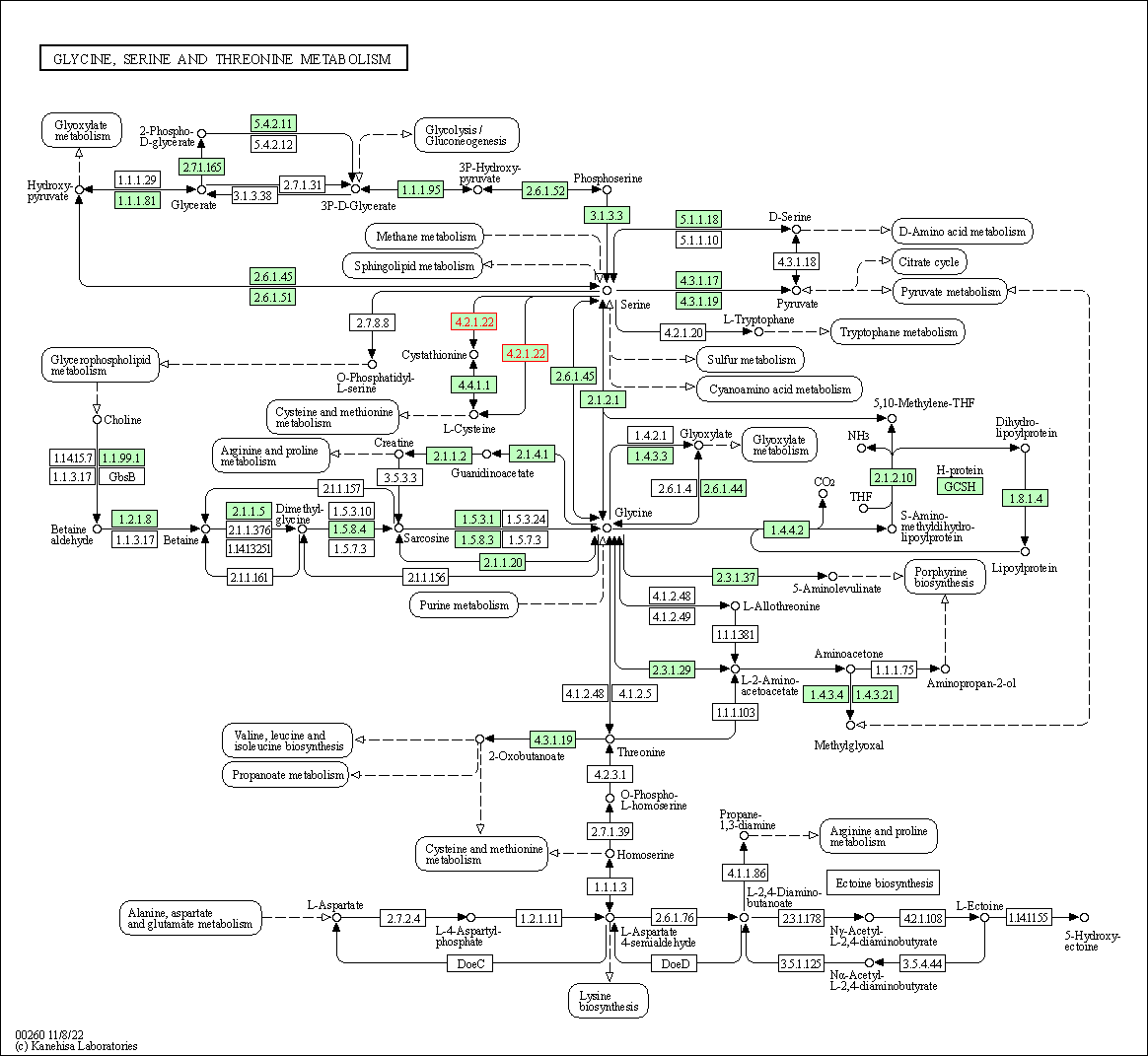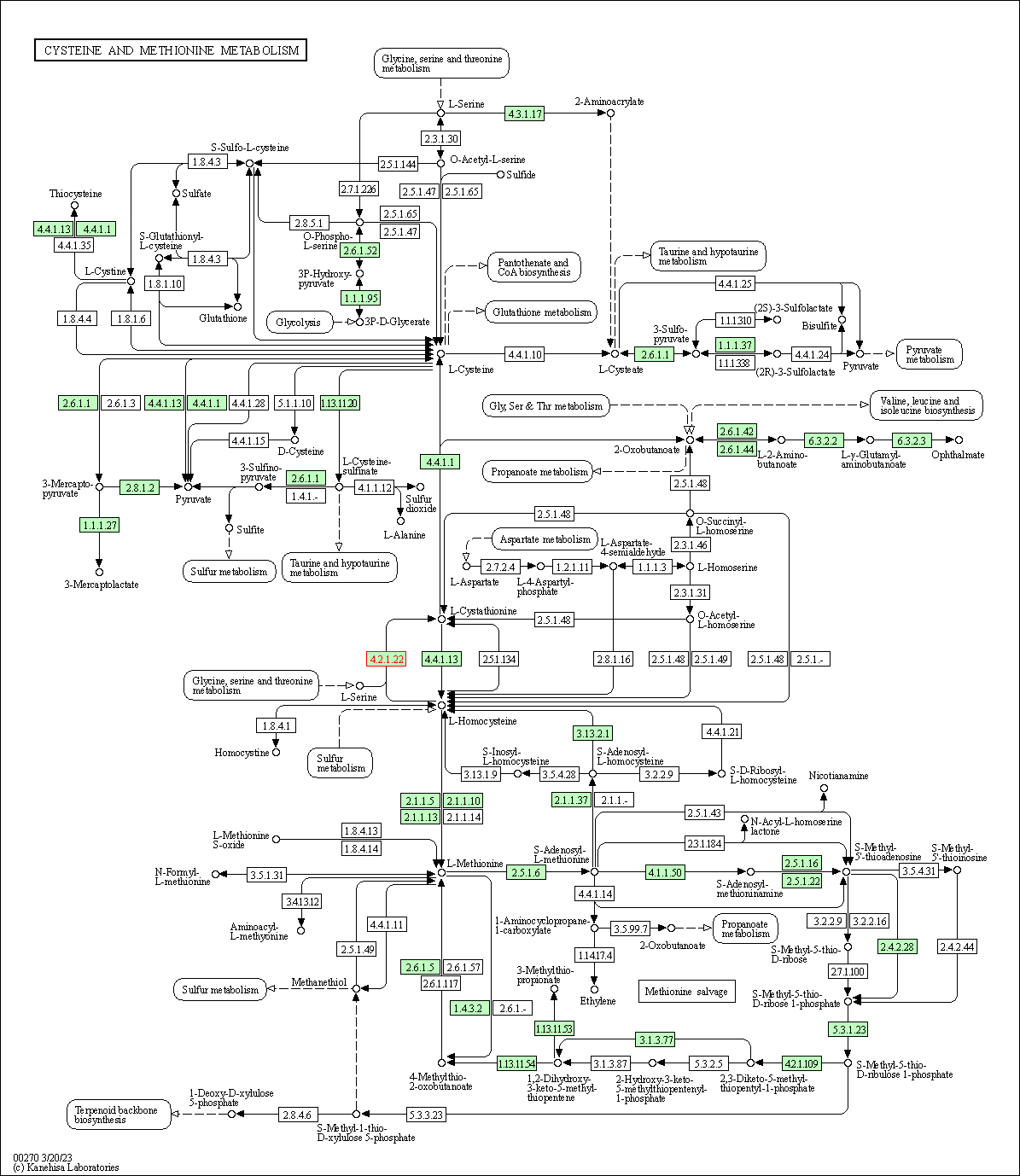Target Information
| Target General Information | Top | |||||
|---|---|---|---|---|---|---|
| Target ID |
T85309
(Former ID: TTDR00526)
|
|||||
| Target Name |
Cystathionine beta-synthase (CBS)
|
|||||
| Synonyms |
Serine sulfhydrase; Beta-thionase
Click to Show/Hide
|
|||||
| Gene Name |
CBS
|
|||||
| Target Type |
Clinical trial target
|
[1] | ||||
| Disease | [+] 1 Target-related Diseases | + | ||||
| 1 | Metabolism inborn error [ICD-11: 5C50] | |||||
| Function |
Hydro-lyase catalyzing the first step of the transsulfuration pathway, where the hydroxyl group of L-serine is displaced by L-homocysteine in a beta-replacement reaction to form L-cystathionine, the precursor of L-cysteine. This catabolic route allows the elimination of L-methionine and the toxic metabolite L-homocysteine. Also involved in the production of hydrogen sulfide, a gasotransmitter with signaling and cytoprotective effects on neurons.
Click to Show/Hide
|
|||||
| BioChemical Class |
Alpha-carbonic anhydrase
|
|||||
| UniProt ID | ||||||
| EC Number |
EC 4.2.1.22
|
|||||
| Sequence |
MPSETPQAEVGPTGCPHRSGPHSAKGSLEKGSPEDKEAKEPLWIRPDAPSRCTWQLGRPA
SESPHHHTAPAKSPKILPDILKKIGDTPMVRINKIGKKFGLKCELLAKCEFFNAGGSVKD RISLRMIEDAERDGTLKPGDTIIEPTSGNTGIGLALAAAVRGYRCIIVMPEKMSSEKVDV LRALGAEIVRTPTNARFDSPESHVGVAWRLKNEIPNSHILDQYRNASNPLAHYDTTADEI LQQCDGKLDMLVASVGTGGTITGIARKLKEKCPGCRIIGVDPEGSILAEPEELNQTEQTT YEVEGIGYDFIPTVLDRTVVDKWFKSNDEEAFTFARMLIAQEGLLCGGSAGSTVAVAVKA AQELQEGQRCVVILPDSVRNYMTKFLSDRWMLQKGFLKEEDLTEKKPWWWHLRVQELGLS APLTVLPTITCGHTIEILREKGFDQAPVVDEAGVILGMVTLGNMLSSLLAGKVQPSDQVG KVIYKQFKQIRLTDTLGRLSHILEMDHFALVVHEQIQYHSTGKSSQRQMVFGVVTAIDLL NFVAAQERDQK Click to Show/Hide
|
|||||
| 3D Structure | Click to Show 3D Structure of This Target | PDB | ||||
| ADReCS ID | BADD_A08611 | |||||
| HIT2.0 ID | T44UJK | |||||
| Drugs and Modes of Action | Top | |||||
|---|---|---|---|---|---|---|
| Clinical Trial Drug(s) | [+] 1 Clinical Trial Drugs | + | ||||
| 1 | OT-58 | Drug Info | Phase 1/2 | Homocystinuria | [2] | |
| Mode of Action | [+] 2 Modes of Action | + | ||||
| Replacement | [+] 1 Replacement drugs | + | ||||
| 1 | OT-58 | Drug Info | [3] | |||
| Inhibitor | [+] 2 Inhibitor drugs | + | ||||
| 1 | aminooxyacetic acid | Drug Info | [1] | |||
| 2 | Heme | Drug Info | [4] | |||
| Cell-based Target Expression Variations | Top | |||||
|---|---|---|---|---|---|---|
| Cell-based Target Expression Variations | ||||||
| Drug Binding Sites of Target | Top | |||||
|---|---|---|---|---|---|---|
| Ligand Name: Pyridoxal phosphate | Ligand Info | |||||
| Structure Description | Crystal structure of human cystathionine beta-synthase (delta516-525) at 2.0 angstrom resolution | PDB:4COO | ||||
| Method | X-ray diffraction | Resolution | 2.00 Å | Mutation | No | [5] |
| PDB Sequence |
WIRPDAPSRC
52 TWQLGRPASE62 SPHHHTAPAK72 SPKILPDILK82 KIGDTPMVRI92 NKIGKKFGLK 102 CELLAKCEFF112 NAGGSVKDRI122 SLRMIEDAER132 DGTLKPGDTI142 IEPTSGNTGI 152 GLALAAAVRG162 YRCIIVMPEK172 MSSEKVDVLR182 ALGAEIVRTP192 TNARFDSPES 202 HVGVAWRLKN212 EIPNSHILDQ222 YRNASNPLAH232 YDTTADEILQ242 QCDGKLDMLV 252 ASVGTGGTIT262 GIARKLKEKC272 PGCRIIGVDP282 EGSILAEPEE292 LNQTEQTTYE 302 VEGIGYDFIP312 TVLDRTVVDK322 WFKSNDEEAF332 TFARMLIAQE342 GLLCGGSAGS 352 TVAVAVKAAQ362 ELQEGQRCVV372 ILPDSVRNYM382 TKFLSDRWML392 QKGFLKEEDL 402 TEKKPWWWHL412 RVQELGLSAP422 LTVLPTITCG432 HTIEILREKG442 FDQAPVVDEA 452 GVILGMVTLG462 NMLSSLLAGK472 VQPSDQVGKV482 IYKQFKQIRL492 TDTLGRLSHI 502 LEMDHFALVV512 HEQMVFGVVT535 AIDLLNFVAA545 QER
|
|||||
|
|
VAL118
4.629
LYS119
1.631
SER147
4.724
ASN149
2.893
ASN228
4.686
HIS232
4.328
SER254
3.567
VAL255
3.696
GLY256
2.872
THR257
2.701
GLY258
2.865
|
|||||
| Click to View More Binding Site Information of This Target and Ligand Pair | ||||||
| Ligand Name: Ademetionine | Ligand Info | |||||
| Structure Description | 1.7 A resolution structure of human cystathionine beta-synthase regulatory domain (del 516-525) in complex with SAM | PDB:4UUU | ||||
| Method | X-ray diffraction | Resolution | 1.71 Å | Mutation | No | [5] |
| PDB Sequence |
NLYFQSMKPW
408 WWHLRVQELG418 LSAPLTVLPT428 ITCGHTIEIL438 REKGFDQAPV448 VDEAGVILGM 458 VTLGNMLSSL468 LAGKVQPSDQ478 VGKVIYKQFK488 QIRLTDTLGR498 LSHILEMDHF 508 ALVVHEQQRQ528 MVFGVVTAID538 LLNFVAA
|
|||||
|
|
||||||
| Click to View More Binding Site Information of This Target and Ligand Pair | ||||||
| Click to View More Binding Site Information of This Target with Different Ligands | ||||||
| Different Human System Profiles of Target | Top |
|---|---|
|
Human Similarity Proteins
of target is determined by comparing the sequence similarity of all human proteins with the target based on BLAST. The similarity proteins for a target are defined as the proteins with E-value < 0.005 and outside the protein families of the target.
A target that has fewer human similarity proteins outside its family is commonly regarded to possess a greater capacity to avoid undesired interactions and thus increase the possibility of finding successful drugs
(Brief Bioinform, 21: 649-662, 2020).
Human Tissue Distribution
of target is determined from a proteomics study that quantified more than 12,000 genes across 32 normal human tissues. Tissue Specificity (TS) score was used to define the enrichment of target across tissues.
The distribution of targets among different tissues or organs need to be taken into consideration when assessing the target druggability, as it is generally accepted that the wider the target distribution, the greater the concern over potential adverse effects
(Nat Rev Drug Discov, 20: 64-81, 2021).
Human Pathway Affiliation
of target is determined by the life-essential pathways provided on KEGG database. The target-affiliated pathways were defined based on the following two criteria (a) the pathways of the studied target should be life-essential for both healthy individuals and patients, and (b) the studied target should occupy an upstream position in the pathways and therefore had the ability to regulate biological function.
Targets involved in a fewer pathways have greater likelihood to be successfully developed, while those associated with more human pathways increase the chance of undesirable interferences with other human processes
(Pharmacol Rev, 58: 259-279, 2006).
Human Similarity Proteins
Human Tissue Distribution
Human Pathway Affiliation
|
|
|
There is no similarity protein (E value < 0.005) for this target
|
|
Note:
If a protein has TS (tissue specficity) scores at least in one tissue >= 2.5, this protein is called tissue-enriched (including tissue-enriched-but-not-specific and tissue-specific). In the plots, the vertical lines are at thresholds 2.5 and 4.
|
| KEGG Pathway | Pathway ID | Affiliated Target | Pathway Map |
|---|---|---|---|
| Glycine, serine and threonine metabolism | hsa00260 | Affiliated Target |

|
| Class: Metabolism => Amino acid metabolism | Pathway Hierarchy | ||
| Cysteine and methionine metabolism | hsa00270 | Affiliated Target |

|
| Class: Metabolism => Amino acid metabolism | Pathway Hierarchy | ||
| Chemical Structure based Activity Landscape of Target | Top |
|---|---|
| Target Poor or Non Binders | Top | |||||
|---|---|---|---|---|---|---|
| Target Poor or Non Binders | ||||||
| Target Regulators | Top | |||||
|---|---|---|---|---|---|---|
| Target-interacting Proteins | ||||||
| References | Top | |||||
|---|---|---|---|---|---|---|
| REF 1 | URL: http://www.guidetopharmacology.org Nucleic Acids Res. 2015 Oct 12. pii: gkv1037. The IUPHAR/BPS Guide to PHARMACOLOGY in 2016: towards curated quantitative interactions between 1300 protein targets and 6000 ligands. (Target id: 1443). | |||||
| REF 2 | ClinicalTrials.gov (NCT03406611) OT-58 as an Enzyme Therapy for Patients With Homocystinuria Caused by Cystathionine Beta-Synthase Deficiency. U.S. National Institutes of Health. | |||||
| REF 3 | Classical homocystinuria: From cystathionine beta-synthase deficiency to novel enzyme therapies. Biochimie. 2020 Jun;173:48-56. | |||||
| REF 4 | The Protein Data Bank. Nucleic Acids Res. 2000 Jan 1;28(1):235-42. | |||||
| REF 5 | Inter-domain communication of human cystathionine beta-synthase: structural basis of S-adenosyl-L-methionine activation. J Biol Chem. 2014 Dec 26;289(52):36018-30. | |||||
If You Find Any Error in Data or Bug in Web Service, Please Kindly Report It to Dr. Zhou and Dr. Zhang.

